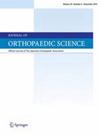社区生活的中老年人群中弥漫性特发性骨骼增生的患病率和特征:雅库莫研究。
IF 1.5
4区 医学
Q3 ORTHOPEDICS
引用次数: 0
摘要
背景:随着人口老龄化,弥漫性特发性骨骼增生症(DISH)的发病率呈上升趋势。无症状DISH可降低脊柱活动范围(ROM)并导致骨折。然而,DISH患者在经历骨折和其他严重疾病之前的患病率或身体功能尚不清楚。本研究旨在根据年龄和性别调查社区居民DISH的患病率,并描述他们的身体功能、ROM和骨脆性。方法:受试者为2018年和2019年参加健康检查的社区志愿者。总体而言,455名受试者(平均年龄64.2±9.7岁;177名男性)被纳入分析。根据Resnick报告的标准,我们进行了全脊柱侧位放射照相术来检测DISH。我们比较了年龄、性别、体重指数(BMI)、肌肉力量和行走测试结果、SpinalMouse®测量的ROM以及有无DISH的跟骨定量超声(QUS)。结果:83例(18.2%)患者检测到DISH。DISH组年龄较大(69.8 y.o.vs.63.0 y.o.;p2,p结论:患有DISH的受试者腰椎ROM和跟骨QUS骨密度降低。然而,在没有主观症状的情况下,患有和不患有DISH受试者的肌肉力量和行走能力等身体功能相似。本文章由计算机程序翻译,如有差异,请以英文原文为准。
The prevalence and characteristics of diffuse idiopathic skeletal hyperostosis in the community-living middle-aged and elderly population: The Yakumo study
Background
The incidence of diffuse idiopathic skeletal hyperostosis (DISH) is increasing with the aging of the population. Asymptomatic DISH can decrease the spinal range of motion (ROM) and cause fractures. However, the prevalence or physical function of patients with DISH before experiencing fractures and other serious conditions is unclear. This study aimed to investigate the prevalence of DISH in the community residents on the basis of age and sex and characterize their physical function, ROM, and bone fragility.
Methods
The subjects were community volunteers who attended a health checkup in 2018 and 2019. Overall, 455 subjects (mean age, 64.2 ± 9.7 years; 177 men) were included for analysis. We performed whole-spine lateral radiography for detecting DISH according to the criteria reported by Resnick. We compared the age, sex, body mass index (BMI), results of muscle strength and walking tests, ROM measured by SpinalMouse®, and quantitative ultrasound (QUS) of calcaneus with and without DISH.
Results
DISH was detected in 83 (18.2%) cases. The DISH group was older (69.8 y.o. vs. 63.0 y.o.; p < 0.05) and comprised more men (prevalence: men, 27.7%; women, 12.2%; p < 0.001). BMI was high in the DISH group (24.8 vs. 23.3 kg/m2, p < 0.05). SpinalMouse measurements showed the DISH group had a significantly decreased ROM in the lumbar spine (43.2°, 57.2°, p < 0.05). The DISH group had a significantly lower T-score on the QUS measurement in the calcaneus (−2.0, −1.5, p < 0.05). There were, however, no significant differences between groups in both muscle strength test and walking test.
Conclusion
Subjects with DISH had decreased ROM in the lumbar spine and bone mineral density in calcaneal QUS. However, physical functions such as muscle strength and walking ability were similar among subjects with and without DISH without subjective symptoms.
求助全文
通过发布文献求助,成功后即可免费获取论文全文。
去求助
来源期刊

Journal of Orthopaedic Science
医学-整形外科
CiteScore
3.00
自引率
0.00%
发文量
290
审稿时长
90 days
期刊介绍:
The Journal of Orthopaedic Science is the official peer-reviewed journal of the Japanese Orthopaedic Association. The journal publishes the latest researches and topical debates in all fields of clinical and experimental orthopaedics, including musculoskeletal medicine, sports medicine, locomotive syndrome, trauma, paediatrics, oncology and biomaterials, as well as basic researches.
 求助内容:
求助内容: 应助结果提醒方式:
应助结果提醒方式:


